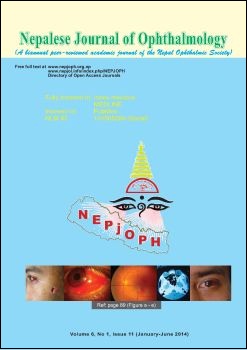Prevalence of and associated risk factors for pterygium in the high altitude communities of Upper Mustang, Nepal
DOI:
https://doi.org/10.3126/nepjoph.v6i1.10774Keywords:
pterygium, prevalence, risk factor, high altitudeAbstract
Objective: To determine the prevalenceof and associated risk factors for pterygiumin the high altitude communities of the Upper Mustang region of Nepal, near the Tibet border.
Materials and methods: Six villages of the Upper Mustang were selected based on the concentration of population. All subjects were permanent residents aged 16 years and older, and recruited through a household census with mobilization of local monks who had been trained as interviewers, and people were invited to attend the eye clinic for a complete examination. A cross-sectional studywas conducted which included the parameters oflaterality, severity, occupation, age, sex and altitude of residence.
Results:The study population comprised 1,319 individuals of which 637 (48.29%) weremale and682 (51.71%) were female.The overall prevalence of pterygium, was 10.08% (133 of 1,319), with 42.86% for males and 57.14% for females. The mean age of the subjects was45.83 years and the mean SD 17.94. The majority of the subjects had a unilateral pterygium. The right eye(n=63) was predominately affected, in 57.80% of the total subjects. Farmers and construction workers, which comprised of 36.09% and 28.57% respectively, had a higher prevalence of pterygium. The most affected age group was the 66 to 75 years group (n=31: 23.31%). The prevalence increased linearly with age. The severe Grade III and Grade IV pterygium were predominant in the age group of 56-65 years, comprising 28.58% of all the cases;the less severe Grade I was also predominant in the same age group,with 23.56%, and Grade II (0-2 mm) was predominant in the age group of 46-55, with 31.03%.
Conclusion: Pterygiumisa significant public health problem in the high altitude communities of Nepal. It is more prevalent amongst the farmers than in the other professionals.
DOI: http://dx.doi.org/10.3126/nepjoph.v6i1.10774
Nepal J Ophthalmol 2014; 6 (2): 65-70
Downloads
Downloads
Published
How to Cite
Issue
Section
License
This license enables reusers to copy and distribute the material in any medium or format in unadapted form only, for noncommercial purposes only, and only so long as attribution is given to the creator.




